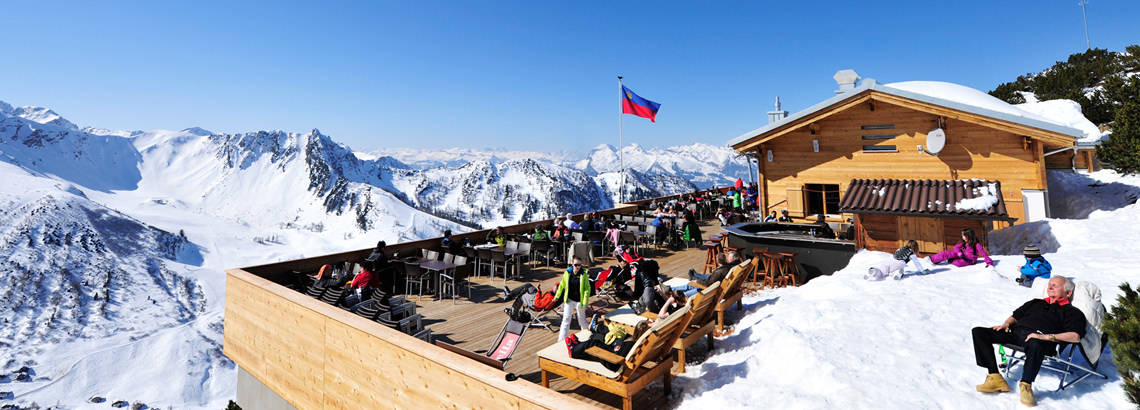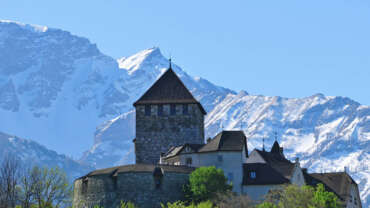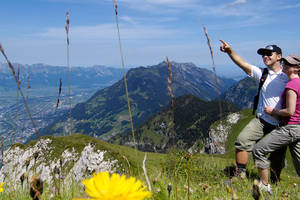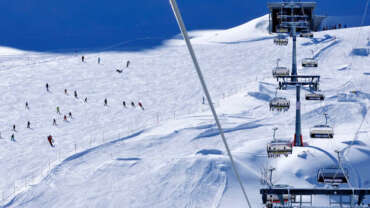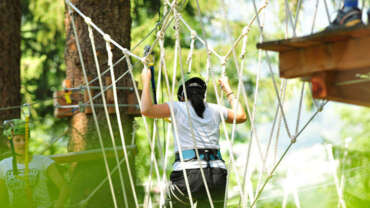Experiences in Liechtenstein
Liechtenstein may be small in size, but it is big when it comes to sights and places of interest. Here in the heart of the Alps there really is something for everyone.
Centre for Art
The so-called “L’Or du Rhin” or “Centre for Art” was built between 1971 and 1974 by the Cuban architect, artist, sculptor and painter Ricardo Porro (1925-2014).
The architect was commissioned by the financier Robert Altmann to design offices together with a gallery. He wanted to combine his private collection of paintings with his offices. For this reason, Ricardo Porro, who had previously worked mainly in Cuba, designed the building in three parts. Offices were to be located on the ground floor, and these were available for letting to tenants. Large exhibition spaces were planned for the upper storeys, which at the same time served as the entrance hall to Robert Altmann’s private offices. The concept behind the structure was that the building should reflect the image of the compact country of Liechtenstein. The project was designed to underscore the fact that Liechtenstein was one of the most important centres of the business world.
The building, which is sturdy and has a strong physical presence while at the same time being energised and dynamic, consists of a complex glass-metal façade with gold-toned windows. The building’s most striking feature is probably the hanging lamellae made of anodised aluminium with a golden shimmer. When a number of the lamellae, which continually moved and emitted sounds, were blown off the façade during a December storm, these were fitted with a ball joint system to prevent them moving. This put an end to the originally intended sound effect.
The Centre for Art can’t be visited from the inside!
DoMus – Museum und Galerie
Housed in Schaan town hall, DoMuS is a cultural centre comprising a gallery in Schaan.
DoMuS was created in 1998 based on the local history museum originally constructed in Schaan in 1982. Today, both the museum and the gallery host only temporary exhibitions, with the latter often displaying work by local artists.
As well as the main museum, DoMuS also encompasses two further buildings in Schaan: the Landweibels-Huus and a traditional coppersmith’s workshop. The Landweibels-Huus is of particular interest because of its architecture and interior, which both give insights into life in Liechtenstein in years gone by. The house also organises art exhibitions between May and October. The coppersmith’s workshop dates back to 1912 and still has all the original equipment and tools on display.
Kuefer Martis Huus
The Küfer Martis Huus is a place of cultural interaction and home to a museum based on the theme of water and, in particular, the Rhine.
Inspired by the municipality’s proximity to the mighty Rhine, the local council in Ruggell decided to create a museum based on water in general and, more specifically, the famous European river’s influence on life in Liechtenstein.
This museum in the historic Küefer Martis Huus contains fascinating exhibits highlighting the importance of water to the principality. There is also a new building next to the museum which is suitable for hosting events and activities.
Kunstmuseum Liechtenstein with Hilti Art Foundation
Opened in the year 2000, the Kunstmusem Liechtenstein in the centre of Vaduz displays a range of modern and contemporary art.
With its carefully curated exhibitions and publications on international art after 1945, this young museum has quickly made an international name for itself. Many of its exhibitions are shown by museums and galleries all over Europe. The façade of this eye-catching building is made of seamlessly cast tinted concrete and black basalt stone. River pebbles embedded in the building’s sanded and polished exterior create a shimmering surface which reflects the light.
The collection of the Kunstmuseum Liechtenstein, which is also the state art collection of the Principality of Liechtenstein, is particularly well known for its three-dimensional works: sculptures, installations and objects. The collection has a particular focus on Arte Povera and Post-Minimal Art. Works from the collection are displayed in temporary exhibitions designed to complement the museum’s changing major exhibitions showcasing international art of the 20th and 21st centuries.
Two buildings – one museum: Kunstmuseum Liechtenstein with the Hilti Art Foundation
In 2015, the Kunstmuseum Liechtenstein was expanded to include a new exhibition building housing the Hilti Art Foundation. This important private collection from Liechtenstein comprises outstanding works of classical modern art and contemporary art. Visitors to the Kunstmuseum Liechtenstein can therefore look forward to 130 years of art history.
Lawena Museum – the history of electricity
Liechtenstein Power Stations operate a museum of electricity in Triesen.
The age of the exhibits range from 1910 to the present day. This dedicated exhibition explores the history of the iron, the electric stove, the washing machine, the radiator, the vacuum cleaner and much more. The museum offers fascinating insights into the development of electric domestic equipment over 100 years. In addition, a special exhibition on “electrical measuring equipment” is also presented on the third floor. A generator and switchgear dating from the year 1926 can also be seen in the Power House.
Liechtenstein NationalMuseum
Dating back to 1438, the building which today houses the Liechtenstein NationalMuseum has a long and varied history.
The building – today part of the former Administrator’s House – has acted as the princely tavern, a customs house and the seat of the government over the many centuries of its existence. Between 1998 and 2008 work was carried out to renovate the building and extend it towards the mountain slope that is home to Vaduz Castle.
As a matter of interest, Johann Wolfgang von Goethe visited the tavern on his travels in 1788.
The Liechtenstein NationalMuseum displays many artefacts describing the history of Liechtenstein and also contains a natural history collection.
MuseumMura – Cutural artefacts collection
With over 10’000 exhibits, Mauren is home to Liechtenstein’s largest collection of cultural artefacts documenting life and customs in the principality in days gone by. The museum is well worth a visit, but guests should make sure they leave enough time to admire and appreciate the huge collection of objects and artefacts. Regular exhibitions often showcase old handicrafts and take an in-depth look at certain aspects of life in Liechtenstein hundreds of years ago, such as how people lived and what it was like at school.
Old bridge over the Rhine in Vaduz
The “Alte Rheinbrücke” is a covered wooden bridge linking the municipalities of Vaduz and Sevelen.
Measuring 135 metres in length, it was completed in 1901 and is today the only remaining wooden bridge spanning the Rhine. Another wooden bridge was, in fact, erected at the same spot 30 years earlier. However, this required rebuilding due to damage caused by the bridge being raised on two separate occasions while work was being carried out redirecting the Rhine.
After the dam in Schaan broke in 1927, the bridge was raised once again. The bridge, which has a wooden roof, was renovated between 2009 and 2010. Motor vehicles are not permitted to use the bridge, making it particularly popular with cyclists.
On the trail of the Walser spirit
Triesenberg is a traditional mountain village in Liechtenstein. With roots as a Walser settlement in the 13th 14th century, the municipality continues to honour its venerable history.
But where precisely is the ancient Walser spirit still tangible after around 700 years?
Traditionally known for being “stubborn”, “idiosyncratic” and “tough” – but in a warm and endearing sense: the inhabitants of Triesenberg, located high above Liechtenstein’s capital Vaduz and the neighbouring municipality of Triesen. Whether they are still so different from the rest of the population in Liechtenstein is anyone’s guess. At any rate, the inhabitants of Triesenberg are unequivocally proud of their heritage. For unlike those who live in the valleys, the inhabitants of the mountain municipality are direct descendants of the Walsers – those stockbreeders and mountain farmers from Valais, who left their homelands in the 12th and 13th century and spread in all directions. The earliest written document to mention the Walsers at Triesenberg dates from 1355. This is an arbitration ruling issued by the comital magistrate, in which they are recognised as owners of a part of Malbun Alp. It is believed, however, that they had already become settled in Liechtenstein by the end of the 13th century.
There are of course many stories about the history of the Walsers and their development in Triesenberg. The following, however, addresses the question of where the Walser spirit can still be discerned today. For even if the municipality has in the interim developed into a popular place to live for Liechtenstein citizens in general, Triesenberg has remained “a very special place” in many respects. And the sense of cohesion between Triesenberg residents is as strong as it has always been.
The pithy Walser dialect
“What did he just say?” many visitors ask when they speak with an original Trisenberg inhabitant. There is good reason for this. Those who are not accustomed to the pithy Walser dialect do indeed find it very difficult to understand. The dialect differs markedly from the dialects spoken in the other municipalities, and is characterised inter alia by its unusually frequent vowels as well as by the shift of the “s” to “sch” and its idiosyncratic diminutive forms. This causes “Mäuse” (mice) to be pronounced “Müüsch” or “Wald” (forest) to be pronounced “Waldi”. For the inhabitants of Triesenberg, it is a remarkable achievement that they have been able to nurture their language over such a long period, and have prevented this from becoming diluted. And it is a fact that the dialect is the most notable shared characteristic of all Walsers. It represents a link stretching back over 700 years between all Walser settlements in the central Alpine region and their origins along the River Rhône.
Masescha Chapel as heritage
The early migrants from Valais initially settled at higher altitudes such as Masescha, before spreading down towards the valley and establishing the hamlet of Triesenberg. To this day, the small chapel on Masescha stands as a historical witness to the earliest period of the Walser. Its “original structure” was probably established as a sacral meeting place for the Walsers shortly after they arrived, and played an important role in the cohesion of these industrious settlers. It was here that people met to honour the Walser Saint Theodul, and to find new strength for future endeavours. In the 15th century, the so-called “nave” was probably added to the original chapel. Since the 19th century, work has been undertaken to prevent further structural deterioration. In 1955 the legendaryTheodul Bell was made part of the municipal coat of arms. To this day – as in days of yore – the Walser Saint Theodul continues to be honoured in the Chapel on Masescha.
The hamlet
Those who stroll through Triesenberg today will encounter ancient traditions on practically every step of their journey. The village has grown organically over the centuries. While the early Walser single farmstead settlements were characteristic of the higher regions such as Masescha and Gnalp, they later spread towards the valley, where they established their typical scattered settlements with hamlets such as Üenaboda, Rotaboda, Fromahus, Steinord, Wangerbärg and Litzi. Although much of the once distinctive hamlets have been incorporated into a larger settlement by the busy construction activity seen since the 1950s, individual hamlets – such as for example Prufatscheng – have been able to preserve the historic character of scattered settlements. This is also partly due to historical preservation activities, which strive to conserve historic wooden stables and buildings. These include the 400 year-old “Walser House” that stands at the centre of Triesenberg, and makes the domestic culture of the 19th century tangible for visitors to this day.
“Hands-on” Walser culture
Being proud of its roots, the municipality invests a great deal in memorials of its heritage. The Triesenburg Heritage Museum, for example, to which the 400 year-old Walser House also belongs, informs visitors about the history, culture and customs of the Walser. For those who are interested in the sagas, legends and stories of the ancient people, the Walser Saga Path is ideal. Hikers encounter bizarre figures here, such as for example the “Wildmannli” (“Wild Man”) or the “Feuerroten Geissbock” (“Fire-Red Billy-Goat”), and discover what the “Nachtvolk” (“Night People”) are all about. A very special adventure path. Those who seek further evidence of the “veritable” Walser spirit in Triesenberg are recommended to attend one of the annual Walser Meetings. At these folklore events, where typical folk costumes are worn, Walsers assemble from the scattered settlements to strengthen their sense of identity and to honour their venerable history. The 17th International Walser Meeting was held in Triesenberg in 2010. A major and boisterous event that is still recalled affectionately to this day by the inhabitants of the municipality.
Parish Church „Cathedral“ St. Florin
Although the first documentary evidence was recorded in a rental-roll of the chapter of the Cathedral in Chur around 1375, it may be assumed that the initial stages of the Chapel of St. Florin date back to the last quarter of the first centuries.
Originally it could have been a private chapel belonging to a nobleman’s property. The rights of patronage belonged to the owner of the small castle. The Foundation of the Curate 1395, further endowments in the 15th century, 1842 Curacy, 1844 new cemetry for the entire parish. 1873 new Gothic, church with three aisles according to the plans of the Viennese architect Friedrich von Schmidt. 1874 demolition of the old chapel of St. Florin. The parish church St. Florin was raised to the status of a Cathedral on 2./21. December 1997 in connection with the setting up of the Archdiocese, Vaduz. Renovation of the interior of the parish church 1965 – 1968, exterior 1975-1977. – In the Castle of Vaduz the Chapel of St. Anna has certainly been in existence since the late Middle Ages and underwent renovation in the 16th century; the last restoration was completed in 1995.
Beside the Parish Church, there is the burial place for the Family of the Prince. Here amongst others also the father of present Ruling Prince, Franz Josef II and his wife Princess Gina have been buried.
Parliament building in Vaduz
The parliament lies at the heart of the Peter-Kaiser-Platz square, just a stone’s throw from the government building.
After a proposal to create a new parliament building in Liechtenstein was rejected in a 1993 referendum due to its high cost, the Munich-based architect Hansjörg Göritz designed the building which is currently home to the parliament in 2008.
Göritz was also responsible for redesigning the central Peter-Kaiser-Platz square, named after the famous local historian Peter Kaiser, who represented Liechtenstein at the first publicly and freely elected German National Assembly in St Paul’s Church in Frankfurt in 1848.
Together with the government building and the national archive, the parliament forms the government district in Vaduz.
PostalMuseum of the Principality of Liechtenstein
The PostalMuseum tells the history of Liechtenstein’s postal service over the years and displays a large number of postage stamps past and present.
The PostalMuseum Liechtenstein was founded in 1930 and opened in 1936. It is situated in the centre of Vaduz, in the English Building Art Space, and is part of the Liechtenstein National Museum.
The museum’s main focus is on postage stamps issued by the Principality of Liechtenstein since 1912, including designs, test prints and needle plates. Visitors can also learn about the history of the country’s postal service and admire machines used by postal workers in days gone by.
Princely theatre
Vaduz now offers a very special experience. Old cinema charm meets state-of-the-art cinema LED-technology and offers unseen insights behind the scenes of Vaduz Castle. The capital is complemented by a princely experience. Take a virtual tour to the castle of Vaduz and get cinematographical look life behind the castle walls. Combined with the new train of the Citytrain, a visit to the “Old Cinema” is the ideal recreational pleasure for young and old.
Rathaus Vaduz
Vaduz Town Hall dates from 1932/33. It was extensively renovated in the years 1982 to 1984. The balcony fresco by Johannes Troyer on the south façade depicts St. Urban, the patron saint of wine growers. The municipal coat of arms can be seen carved in stone above the entrance.
In 1931 the Municipal Assembly, and in 1932 the Greater Municipal Council, voted to build a new Vaduz Town Hall. The cost of this project amounted to almost three times the total municipal revenues. The driving force behind the project, which was realised in the years 1932/1933, was the then Mayor, Ludwig Ospelt.
Economic and financial circumstances in Vaduz were anything but robust at the time. Despite this, the population in 1931 was bold enough to approve a project that was estimated would cost up to CHF 350,000.00 to complete. For the time, this was a huge sum, when seen in relation to the annual tax and overall revenues.
On 17 November 1931 the Municipal Assembly voted to build a new Town Hall together with offices for the Bank in Liechtenstein on a site opposite the inn “Engel”. Numerous planners were keen to secure the commission. Franz Roeckle was selected to present his project designs to the Greater Municipal Council on 29 January 1932, and won the commission on the same day. The designs were redrafted several times in close collaboration with the Mayor. On 27 September 1932 the Permanent Municipal Council and on 30 September the Greater Municipal Council approved Roeckle’s revised plans.
Construction work proceeded apace, and the Town Hall was ceremoniously opened on 19 November 1933. In addition to the Mayor’s Office, the Municipal Council and the Municipal Administration, the Vaduz Town Hall was used for a variety of purposes. It housed the Bank in Liechtenstein, the Liechtensteinische Landesbank, the Post Office as well as a number of associations. It was renovated and altered on several occasions.
A thorough renovation took place in 1984 under the auspices of Mayor Arthur Konrad. Since then the Town Hall has been used exclusively for municipal purposes. Ludwig Ospelt (Mayor from 1930 – 1933 and 1936 – 1942) was the first holder of that post who had his office in the Town Hall.
The interior design and external architecture of the Town Hall also needs to be seen in conjunction with the work of various artists. The balcony fresco by Johannes Troyer on the south façade depicts Pope St. Urban, the patron saint of wine growers. The front of the balcony balustrade is decorated with images of winegrowers, while the sides show ears of wheat and corn cobs. The municipal coat of arms carved in stone over the entrance was realised by Engelbert Ospelt. The coat of arms was awarded to the Municipality of Vaduz on 26 July 1978, marking the 40th anniversary of the accession of Prince Franz Josef II.
Red House in Vaduz
The Red House, a gabled stairs structure with a large tower containing living quarters, is located in the Mitteldorf area of Vaduz. The house was built in 1338 and gots its name from the dark-red colour the building has had since the middle of the 19th century. Documents show that work began on another construction on the same site several centuries earlier, before being abandoned in the 15th century. The Red House’s many owners over the years include the St. Johann Monastery.
Since 1807 the building has been in the possession of the Rheinberger family. Egon Rheinberger – a famous painter, sculptor and architect from Liechtenstein – extended the Red House between 1902 and 1905.
Rheinerberger House and Monument
Rheinberger House was one of the first administrative buildings in the present day government quarter.
Rheinerberger House
The Rheinberger House origins date back to the time of the Count of Sulz in the 16th century.In 1826 it was assigned to the family of the Princely Tax Collector (Rentmeister) Johann Peter Rheinberger as his official residence. It was here that in 1839 the later composer Josef Gabriel Rheinberger came into the world. He died in Munich in 1901. The house of his birth passed to state ownership in 1957. Following a thorough renovation in the sixties, it has been the principal premises of the Liechtenstein School of Music since 1969.
Rheinberger Monument
To mark the centenary of Josef Gabriel Rheinberger’s birth in 1939, a competition was held to create a memorial for the composer. The winning project was a design by Franz Marcel Fischer, which was subsequently erected in 1940 in front of Rheinberger House. The monument consists of a bronze bust, depicting Josef Gabriel Rheinberger in a realistic pose. To the left is a relief of a lyre – symbolising music – and to the right an engraved inscription plate.
Schädlerhaus
Schädler House at St. Florinsgasse 3 was built in 1872/73 as a three-storey residential building with rooms for the medical practice of the physicians Karl and Albert Schädler. The residential building, with its historicised, Classical design, replaced the grand tower house that previously occupied the site. This building was erected by Seraphin Pümpel, whose business was based in Feldkirch.
In 1894 the original open terraces on the 2nd and 3rd storeys were converted into glazed verandas. A number of additions were realised on the eastern side of the building during the period to 1905, such as for example stables and a laundry.
The building has been owned by the State of Liechtenstein since 1968. Since then it has housed various agencies of the National Administration. The Registry Office has been located here since 1974. In 1994/95 extensive exterior and interior renovations took place, and the outbuildings were demolished. Today’s modernised interiors date from the time of the last renovation. During the course of these works, great efforts were made to ensure that the wedding room for the Registry Office was well-lit and friendly. The paved forecourt area contains an outline of the floor plan of the lost Chapel of St. Florin, traced using different types of stone and masonry, drawing attention to the building’s cultural setting.
Skiing in Malbun
With its well-prepared pistes and four lifts, including three chairlifts, Malbun is a great skiing location for all the family. The resort has 23 kilometres of slopes catering for skiers and snowboarders of all abilities. As well as offering plenty to challenge experts, Malbun is also an ideal place for children to take their first turns in the Malbi Park Kinderland and to improve their technique on the gentle practice slopes nearby. The car-free resort is particularly popular with families and has a large number of hotels located directly next to the slopes.
Malbun’s long-term commitment to family-friendly services and facilities has been recognised by the Swiss Tourist Board with its Family Destination Award.
Sun terrace at Sareis mountain restaurant
High above the Malbuntal Valley, at 2000m altitude, visitos can enjoy breathtaking views of the mountain landscape from the large terrace of the Sareis mountain restaurant. The eastern slopes of the Malbuntal Valley overlook the Alps of Liechtenstein and the neighbouring region of Vorarlberg in Austria. A chairlift runs from the village of Malbun to the restaurant and sun terrace. Leaving from the restaurant, visitors can also hike to the Pfälzerhütte hut or to the peak of the Ochsenkopf mountain – or why not simply stay right where you are and enjoy the magnificent views as you soak up the rays?
During the winter months the restaurant is the starting point for the excellent piste leading back down into the valley.
The Hollein Building
The architect, designer, artist and teacher Hans Hollein was born in Vienna in 1934. As a versatile design talent he is today one of the world’s most distinguished architects. In 1997 he was commissioned by the Dr.-Ludwig-Marxer Family Foundation to design the structure that is today known as the “Hollein Building”. The form of the building derives from a simple rectangular body that has been transformed into a dynamic, tensioned structural volume through a minor modification. This created a homogeneous building whose roof and façade are not separate elements, but which consist instead of the same stone and the same structure.
The coherence and plasticity of the structure is underscored by the contiguous façade made of verde andeer, which has in equal measure a sophisticated and robust effect.
Traditional farmhouse museum
Located in a farmhouse dating back almost 500 years, this museum in Schellenberg is owned and run by the Liechtenstein National Museum. Located near Eschnerberg mountain in the municipality of Schellenberg, the traditional wooden building was built in 1518 and is today home to a museum showcasing the lifestyle and customs of the local farming community up to the start of the 20th century.
The farmhouse was registered as a protected building in 1993, with the museum created by the Liechtenstein National Museum opening just one year later. As well as the fascinating exhibits on show, the building itself is also a fine example of construction and farming techniques common to the region in the late Middle Ages.
Treasure Chamber of the Principality of Liechtenstein
The TreasureChamber of the Principality of Liechtenstein in Vaduz, the only museum of its kind in the Alps, focuses primarily on exhibits belonging to the Princes of Liechtenstein and other private collectors. The exhibition entitled “The Principality, the World and Outer Space” will show a selection of items from the Princely Collections, including works of art made using precious materials, historic weapons and opulent presents belonging to rulers such as Prince Friedrich II of Liechtenstein and Emperor Kaiser Joseph II of Austria.
Also on display will be a number of exhibits from the collection belonging to Liechtenstein collector Adulf Peter Goop, including a selection of what is one of the world’s finest Easter egg collections. Highlights include many precious Russian Easter eggs, including the world-famous Apple Blossom Egg by Fabergé as well as other Fabergé Easter eggs and goldsmith masterpieces. Visitors will also be able to see lunar rocks collected by the astronauts on board Apollo 11 and Apollo 17 and read about how they made their journey from the Moon to the Principality of Liechtenstein. And, of course, the exhibition would not be complete without the famous design by Koloman Moser for the first postage stamp issued by Liechtenstein.
Walser Museum in Triesenberg
Originally called the “Heimatmuseum”, the Walser Museum was created in 1961 by the parish priest of Triesenberg at the time, Engelbert Bucher. Since 1980 the museum has been located in the centre of the village, next to the Hotel Kulm. Its exhibits tell the history of Triesenberg and the local church and showcase many of the customs and traditions so central to the Walser population’s way of life.
A multimedia show lasting around 25 minutes gives an insight into how the village hs changed over the centuries. As well as the main building itself, the Walser Museum includes a 400-year-old traditional Walser house to the south of the cemetery, where visitors can find out about how the local population lived in the 19th century.
Vaduz Castle
Vaduz Castle lies on a hillside 120 metres above Vaduz. It is the symbol of the capital and can be seen from far away. It is thought that the castle was constructed as a fortress as early as the 12th century, before living quarters were added in 1287. Vaduz Castle is first mentioned in documents dating back to 1322.
The castle came into the ownership of the Princely Family in 1712 and the west wing served as the family’s official residence until 1732. However, after that the building became increasingly dilapidated and fell into disrepair before being rebuilt and renovated between 1905 and 1912. Under Prince Franz Josef II the castle was extended and once again made fit for living. In 1939 the Prince moved in with his family and adopted Vaduz Castle as his official residence.



